Incontri e disavventure (altrui)
21 giugno 2025
- ENGLISH VERSION BELOW -
Ci siamo lasciati a Uvala Liski. Nella prima mattina del 9 giugno verso le 0400 comincia a rinforzare il vento da nordest. In realtà l'ancoraggio si rivela meno protetto di quanto l'analisi della cartina potesse suggerire: infatti le alte montagne a nord di noi fanno accelerare il vento e nonostante il fetch (lo spazio necessario al vento sull'acqua per creare il moto ondoso) ridotto, i 20 nodi sostenuti, con raffiche a 25, portano delle belle onde nella baia. Tutte le barche in rada valutano il da farsi. Intanto ci premuriamo di mettere giù più catena per evitare di arare. Una ad una le altre barche se ne vanno e rimaniamo solo noi e un navigatore solitario tedesco che abbiamo già incontrato in un paio di altri ancoraggi. Ci decidiamo ad andare anche noi. Armiamo già la terza mano alla randa visto che ci sembra una buona occasione per testare anche questa modifica fatta quest'inverno. Finché recuperiamo la nostra ancora vediamo che l'altra barca ha iniziato a disancorare ma sta avendo problemi con il suo vericello: non possiamo fare niente per aiutarlo e speriamo riesca a cavarsela senza problemi, per fortuna è così. Sicuramente essere da soli su una barca a vela rende tutto più complicato.
Appena usciti dalla baia apriamo la trinchetta e la randa: in presenza di vento e onde una barca a vela è più sicura, stabile e confortevole con le vele aperte. Nonostante la poca tela, andiamo veloci; che risveglio!
Nel momento in cui dobbiamo il capo, il vento cala a 13-15 nodi e le onde spariscono. Siamo pigri e lasciamo le vele così come sono tanto ci muoviamo sorprendentemente bene.
Navighiamo fino a Uvala Artaturi che dista 8,5 miglia. Si tratta di una profonda baia all'imboccatura del golfo di Lussinpiccolo.
Rimaniamo qui un paio di notti e la usiamo come base per fare un po' di spesa al carissimo minimarket, riempire le nostre taniche d'acqua, smaltire i rifiuti accumulati e per fare un giro in bici fino a Lussinpiccolo. La cittadina è carina, anche se molto turistica nella zona portuale (da qui partono molti charter) però appena ci si addentra nelle irte viuzze si respira un'aria più autentica.

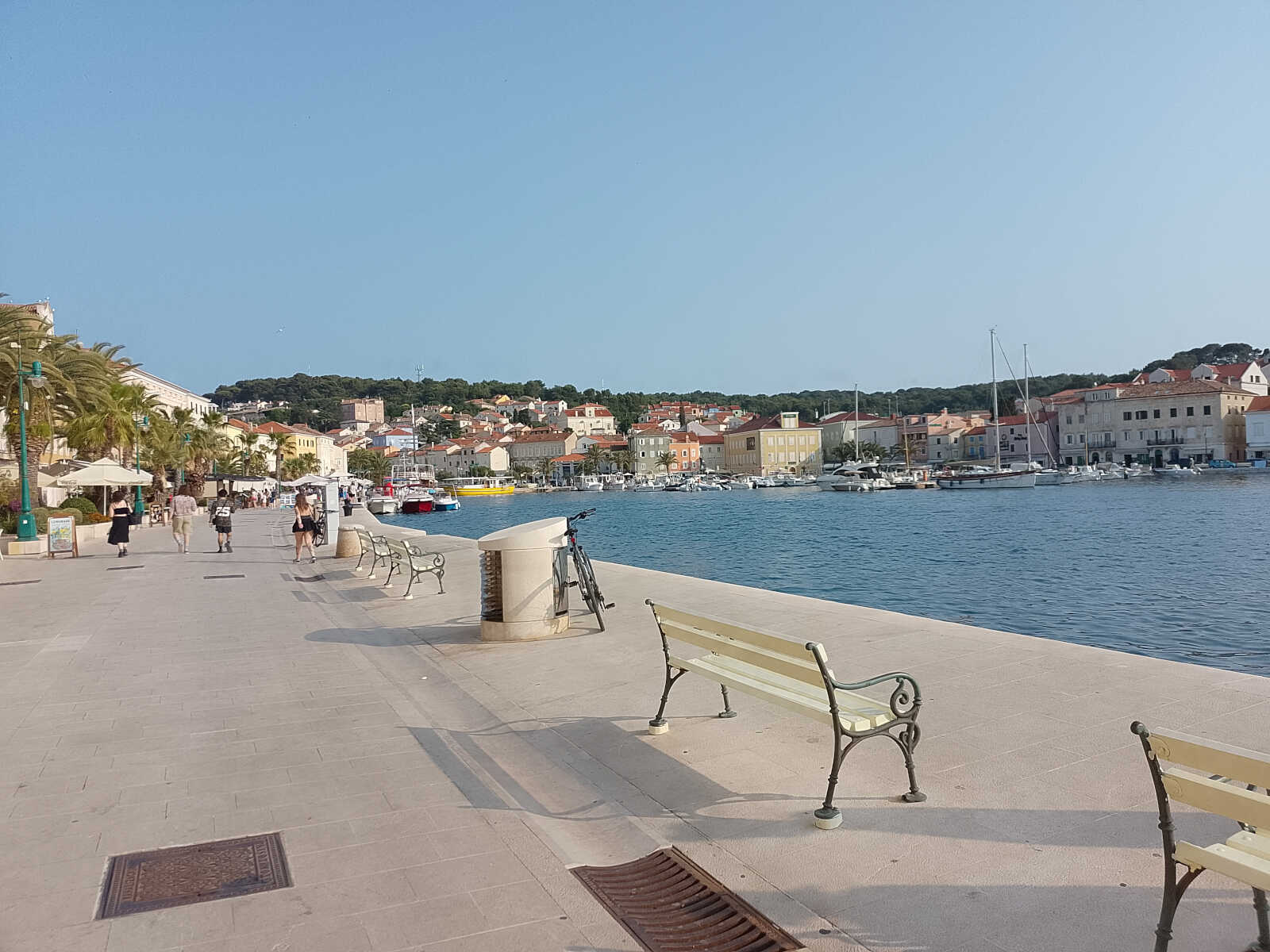
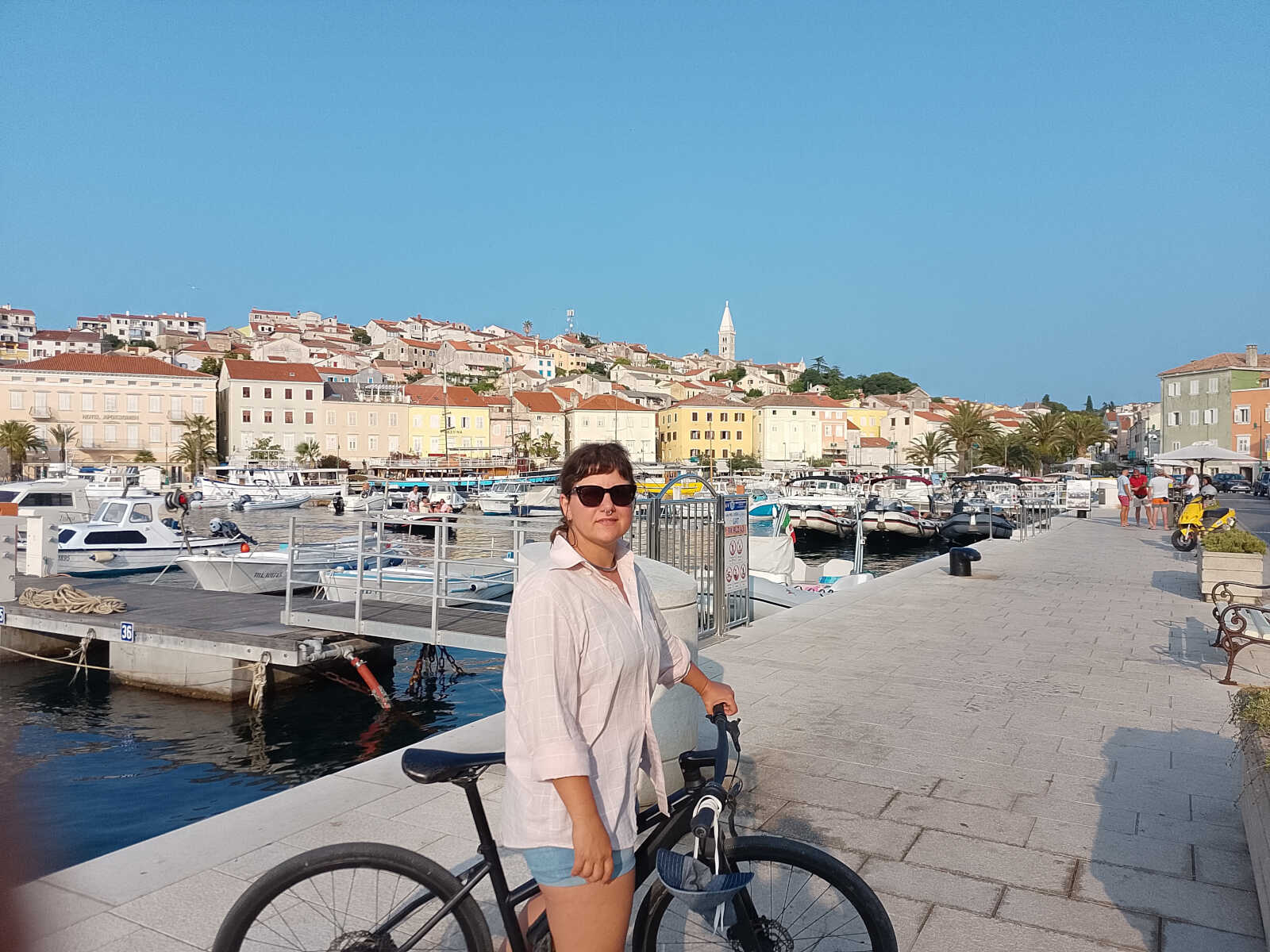
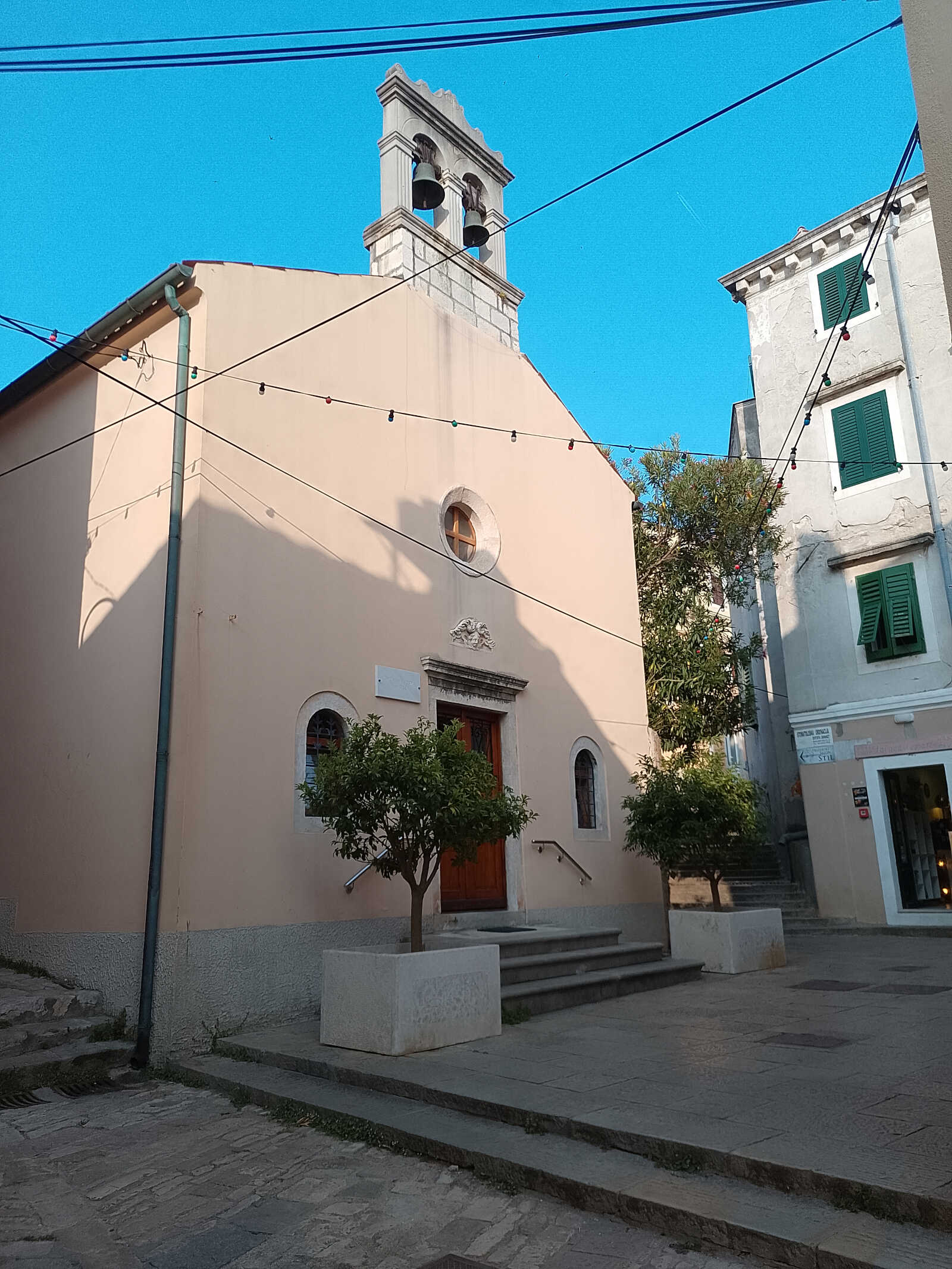
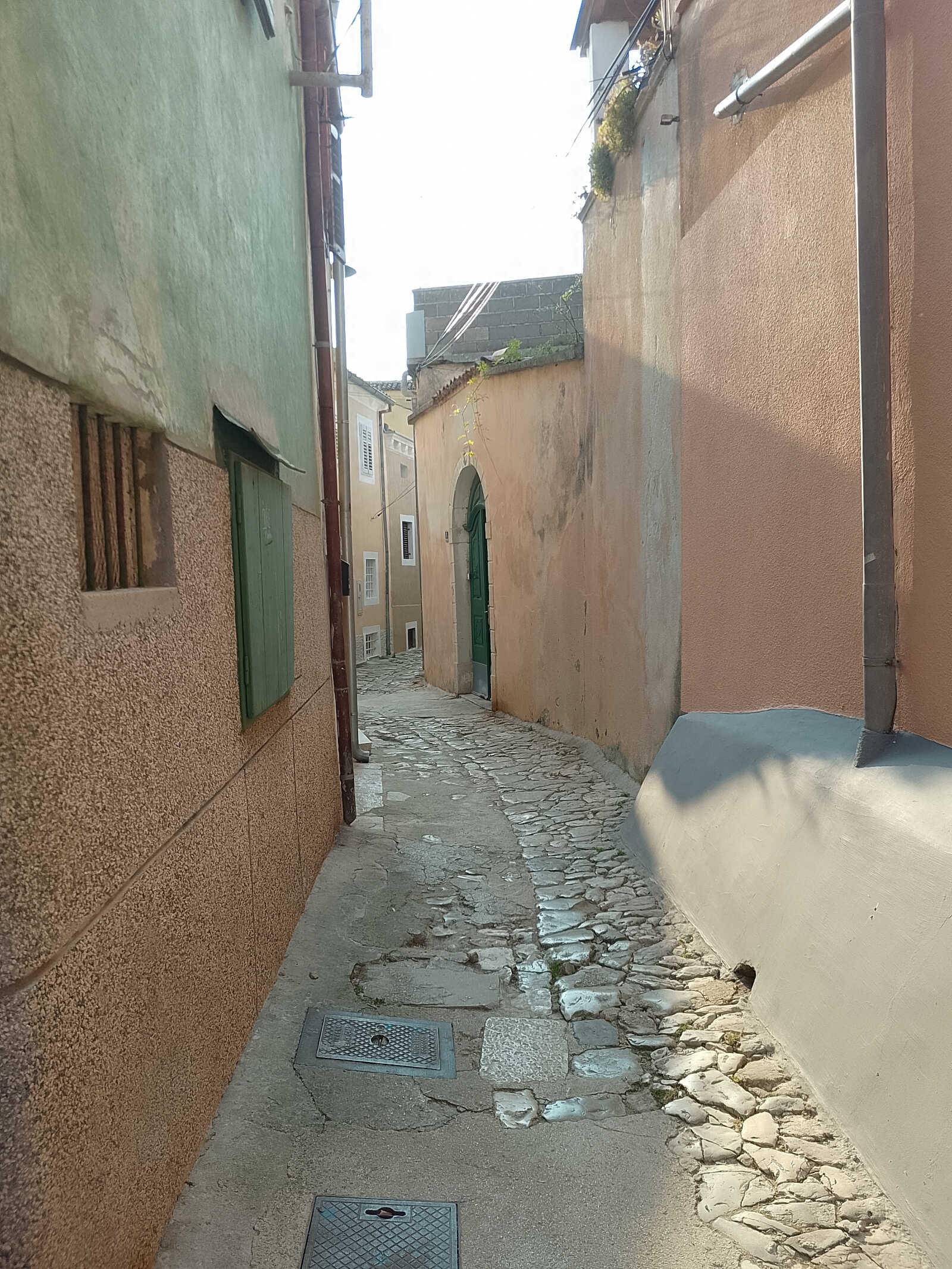
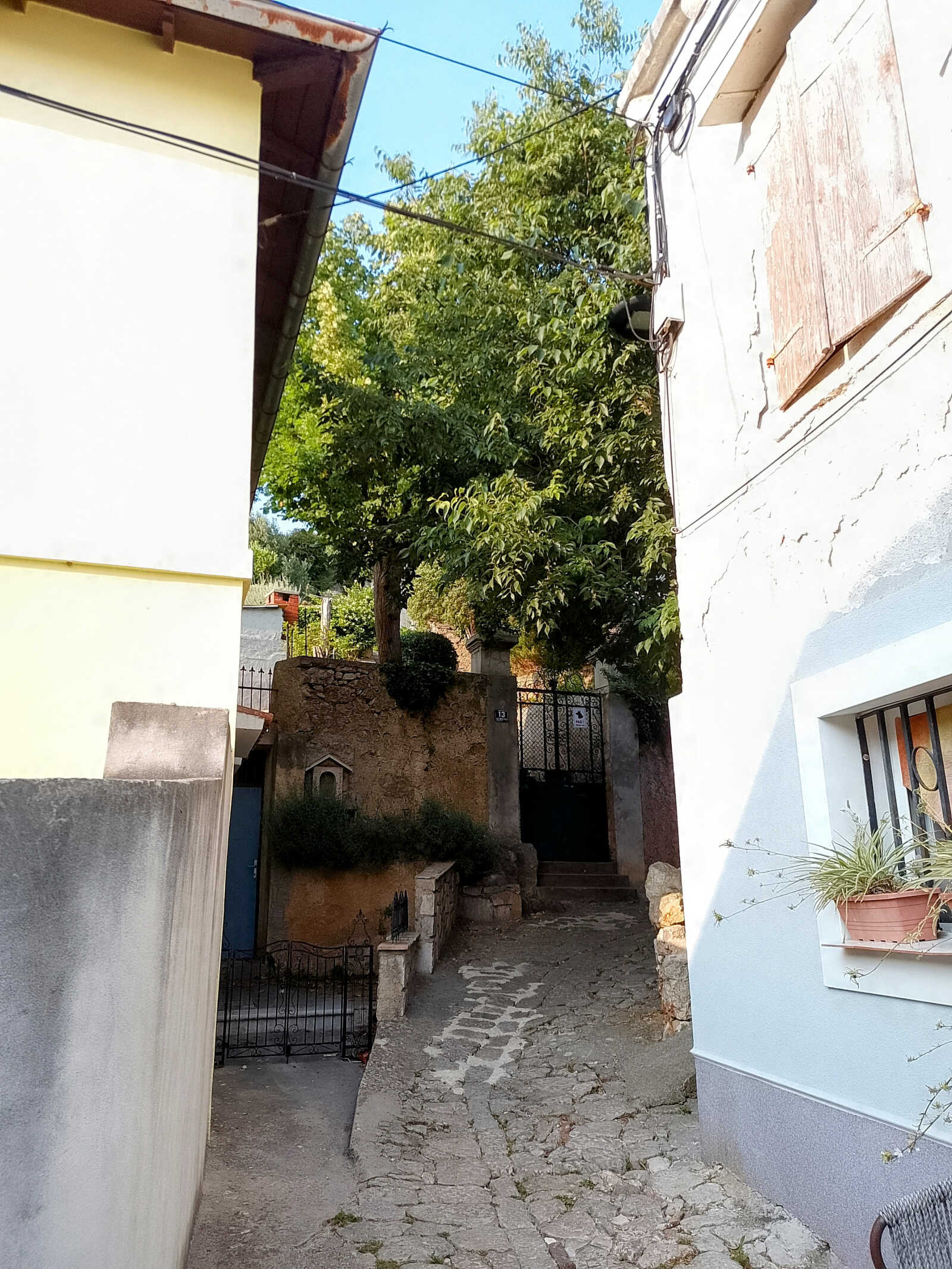
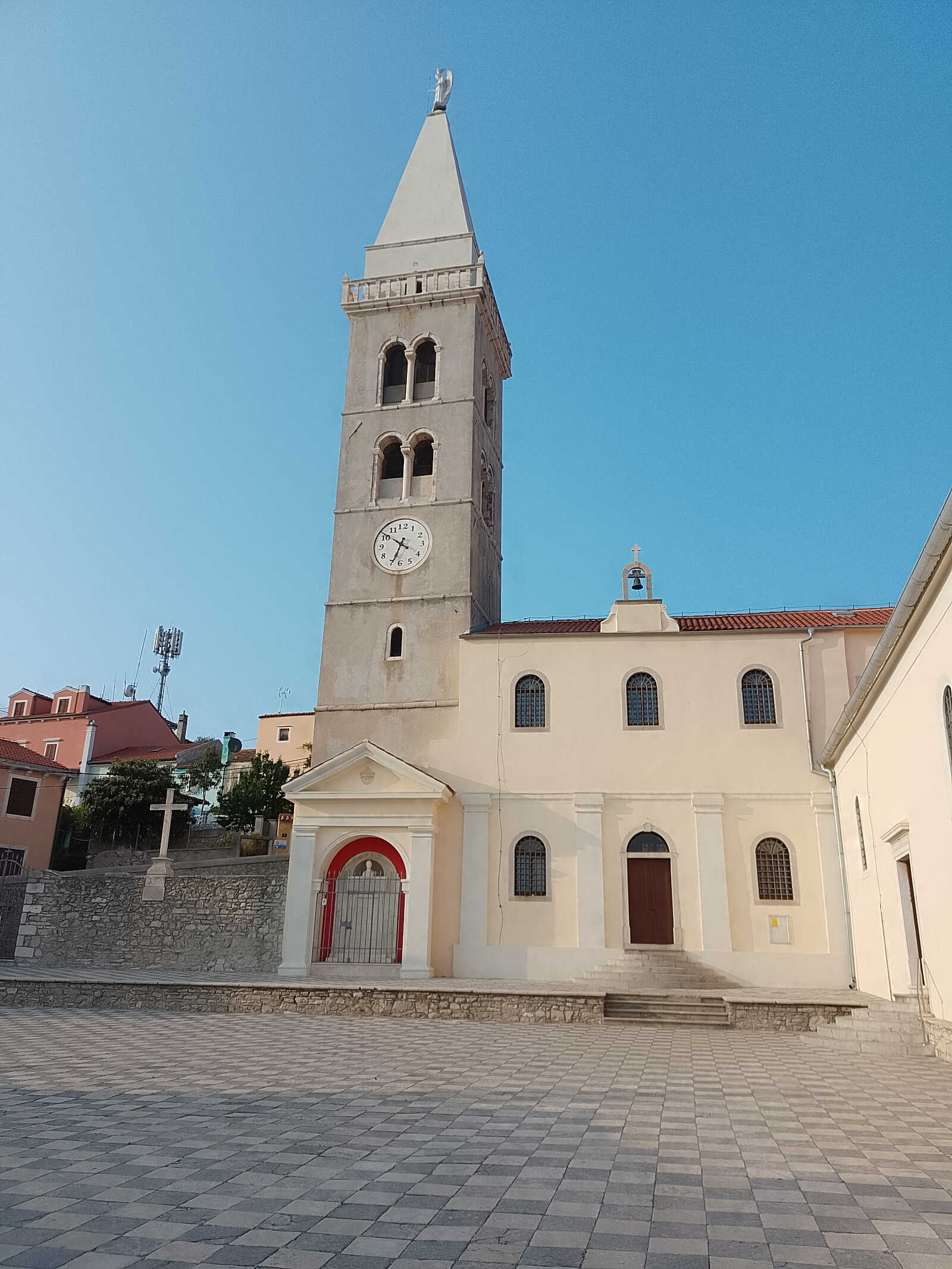
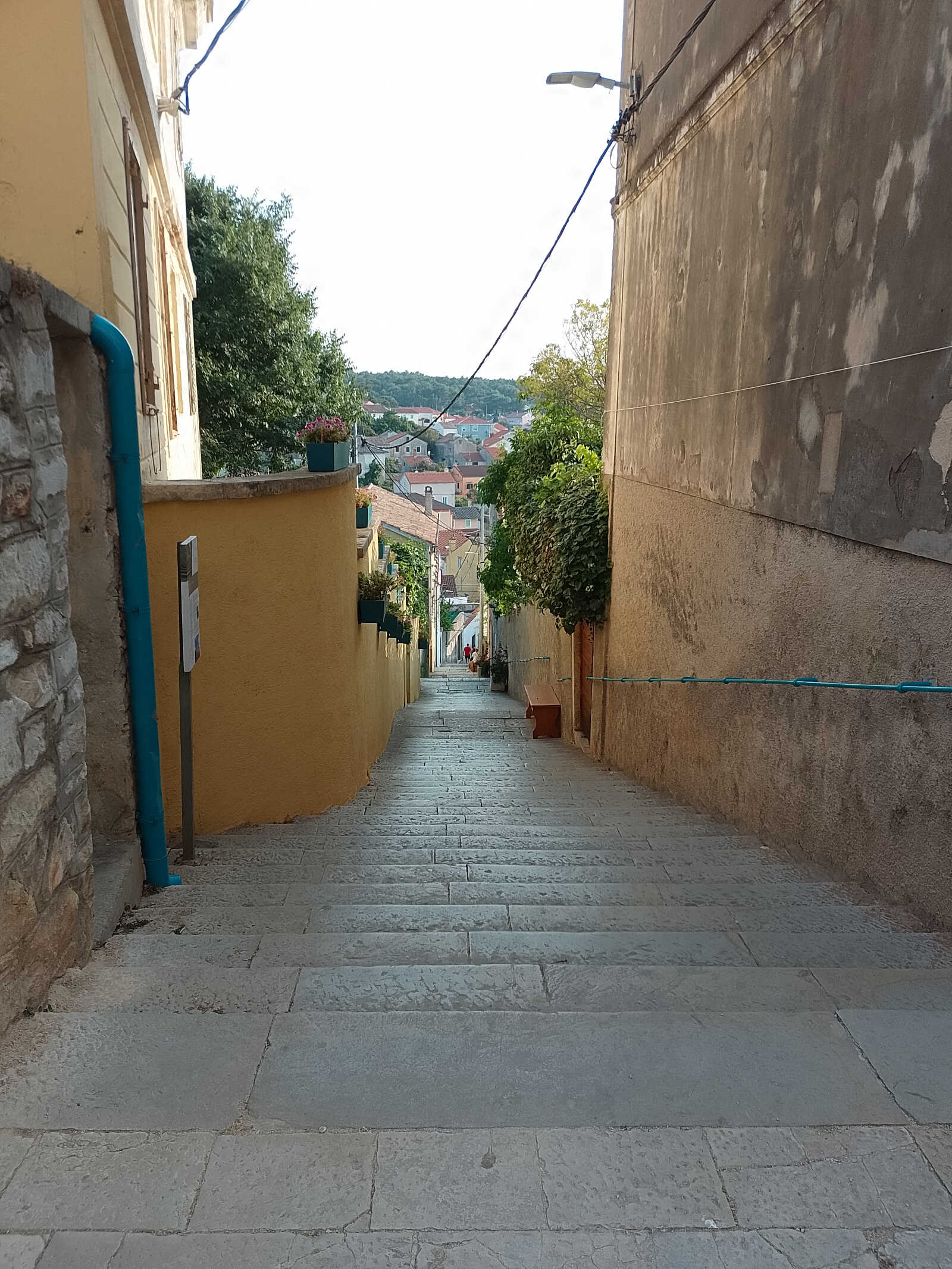
L'11 ci rimettiamo per mare e veleggiamo per 12 miglia verso sudest con il vento al lasco. Ancora una volta rivaleggiamo con successo con barche ben più grandi di noi e l'unica che ci supera lo fa usando il motore oltre alle vele, il che ci amareggia un po': ci sono le condizioni perfette per andare a vela, ma questi pur di arrivare prima all'ancoraggio o in porto per poter fare il più possibile anche in vacanza, se ne fregano e inquinano inutilmente. Purtroppo è il caso per la maggior parte dei charter.
Arriviamo infine nella bella e remota Uvala Parzine, nella parte più meridionale nell'isola di Ilovik. Qui ritroviamo Joschi, la barca tedesca con cui avevamo condiviso la disavventura a Uvala Liski. Dopo così tante volte che ci incontriamo, non possiamo fare a meno di fermarci a salutare e presentarci nel nostro tragitto verso terra con il tender. Finora ci sta tornando più utile il tedesco di ogni altra lingua, visto che in questo periodo della stagione ci sono quasi solo tedeschi e austriaci!
Il sentiero che dalla baia porta al centro abitato di Ilovik è molto bello: l'aria è profumata dalle erbe aromatiche (raccogliamo perfino menta e lavanda selvatica) e ci godiamo gli scorci dei campi di ulivi delimitati dai caratteristici muri a secco.
L'isola è rinomata per la sua diversità floreale.
Il villaggio è grazioso e tranquillo, vorremmo comprare qualcosa al minimarket ma i 9 € per un barattolo di olive e i 7 € per 100g di prosciutto ci convincono ad andarcene con giusto un cavolo cappuccio e qualche pomodoro.

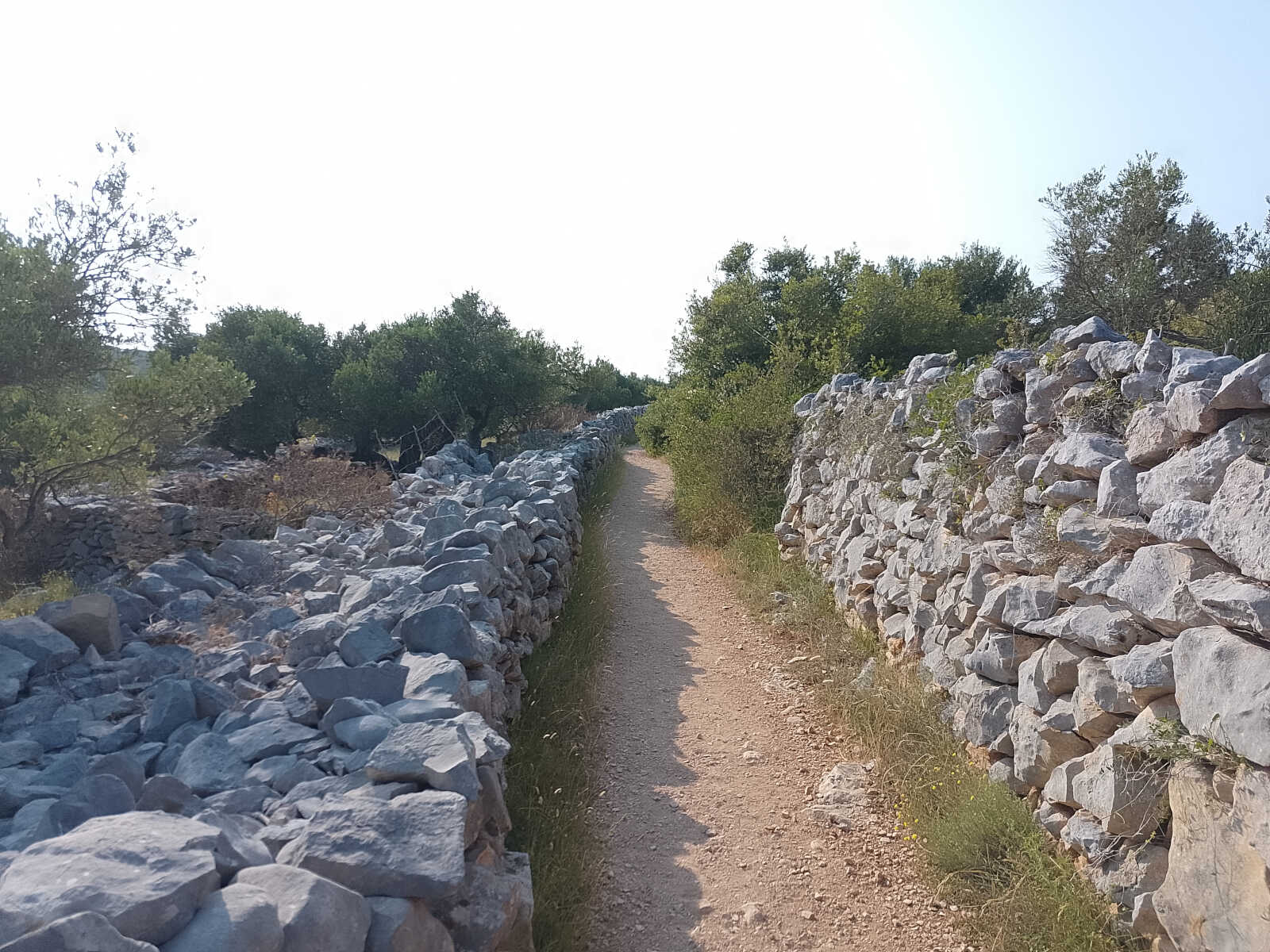
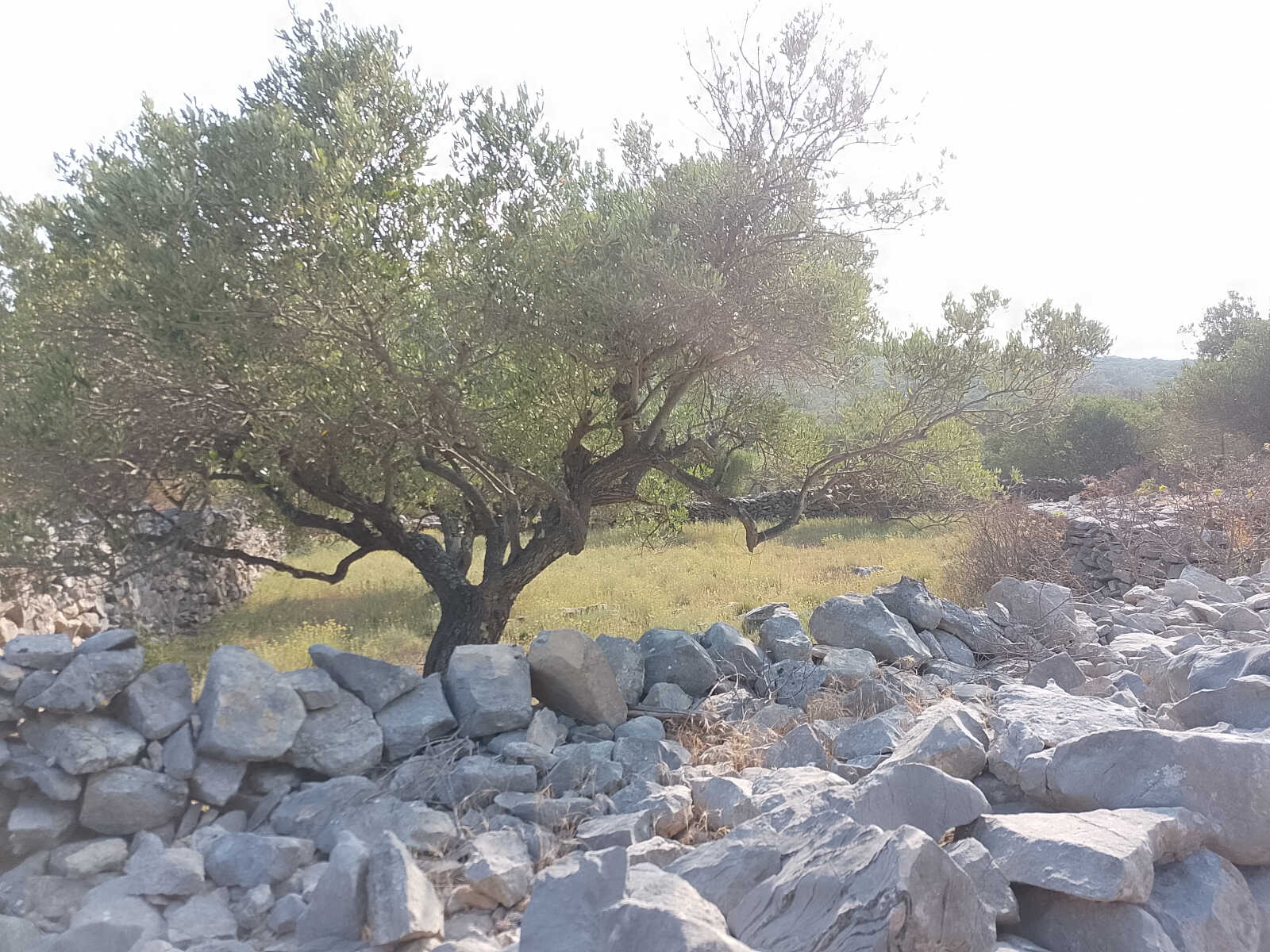
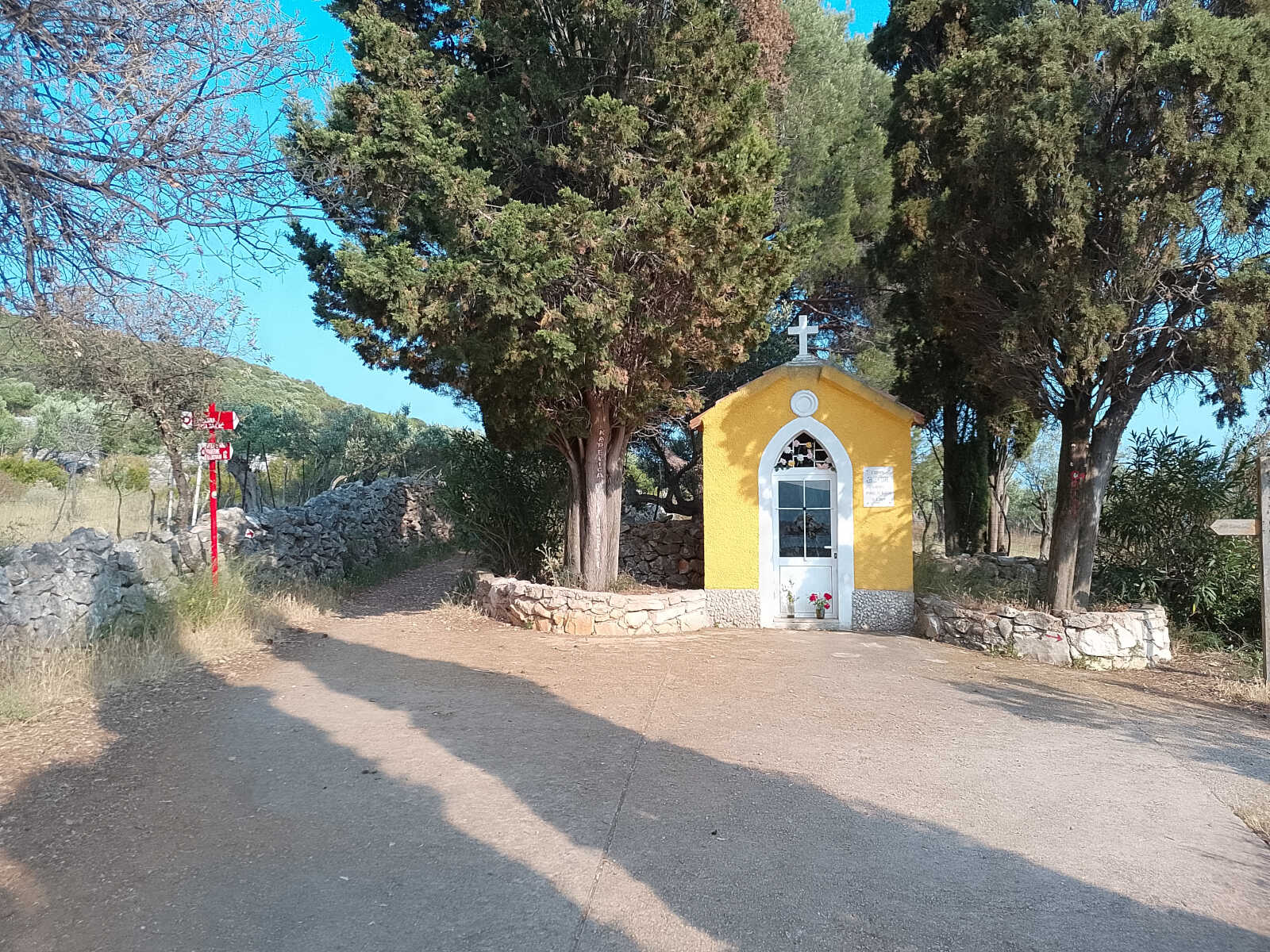
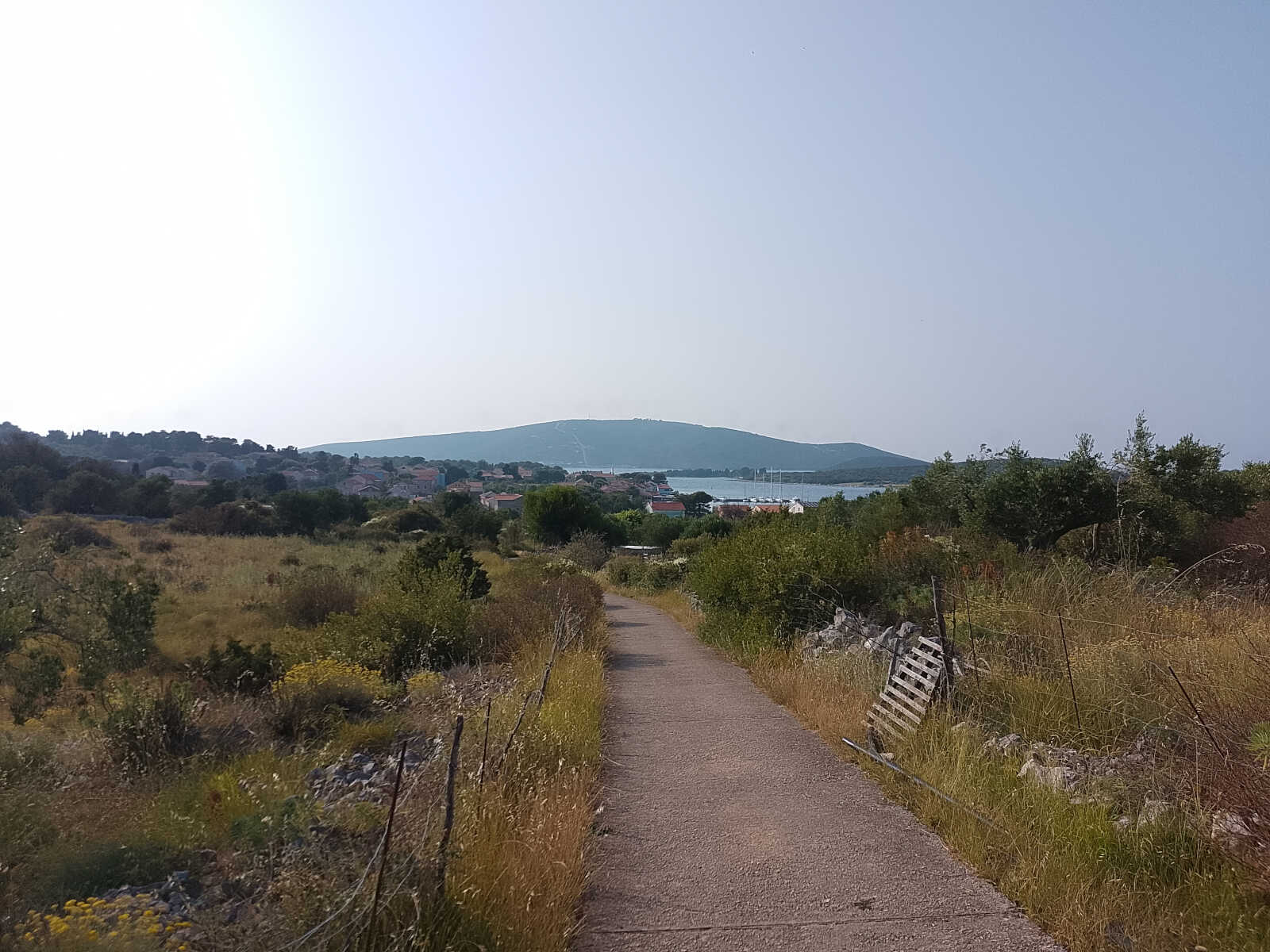
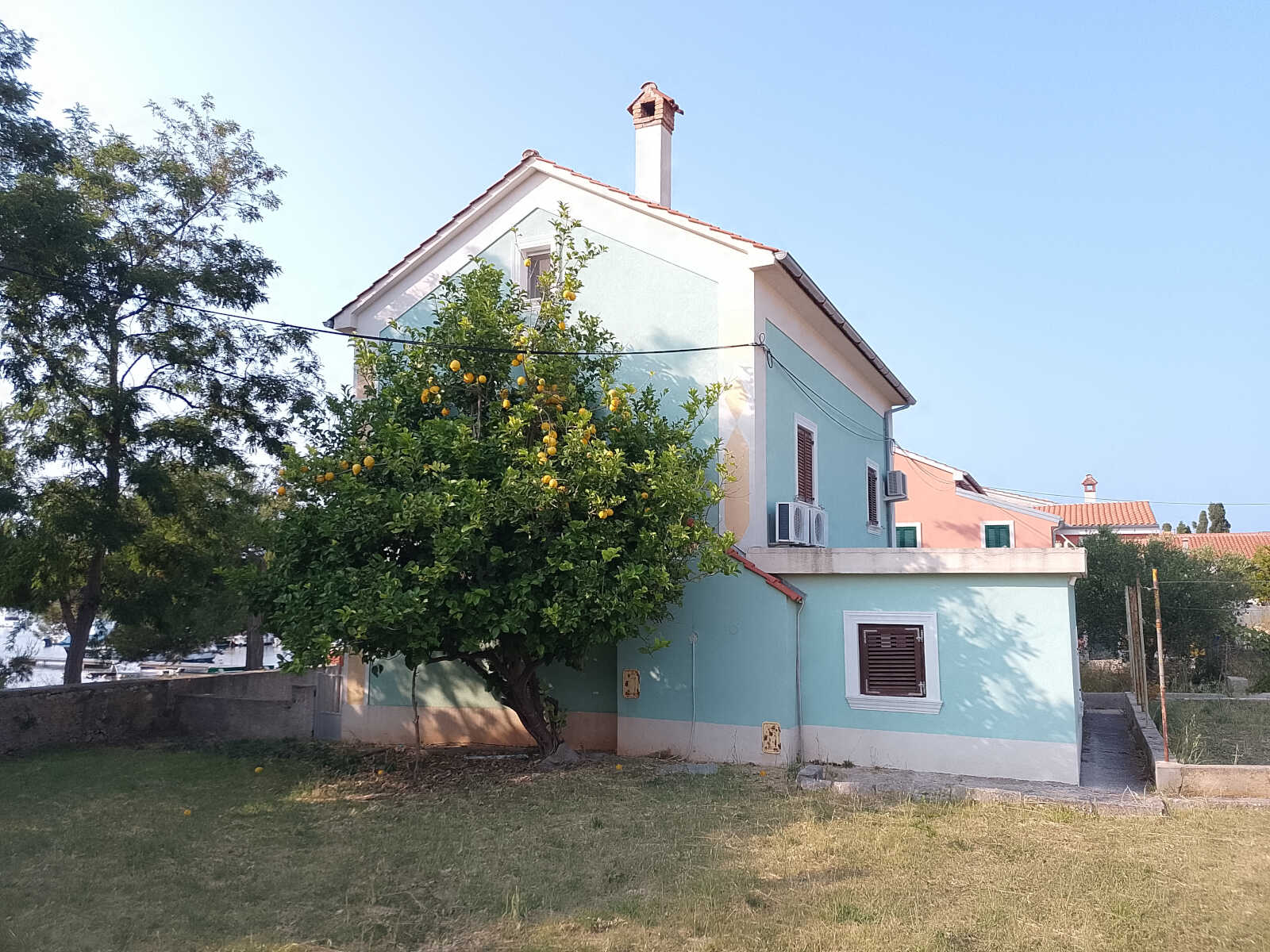
Nel frattempo comincia a delinearsi una potenziale perturbazione con venti molto forti. Abbiamo ancora qualche giorno e decidiamo di spezzare in piccole tappe il percorso per raggiungere quello che abbiamo identificato come rifugio.
Il 13 percorriamo circa 7 M fino ad un selvaggio ancoraggio sulla costa NO di Silba che abbiamo tutto per noi per la notte.
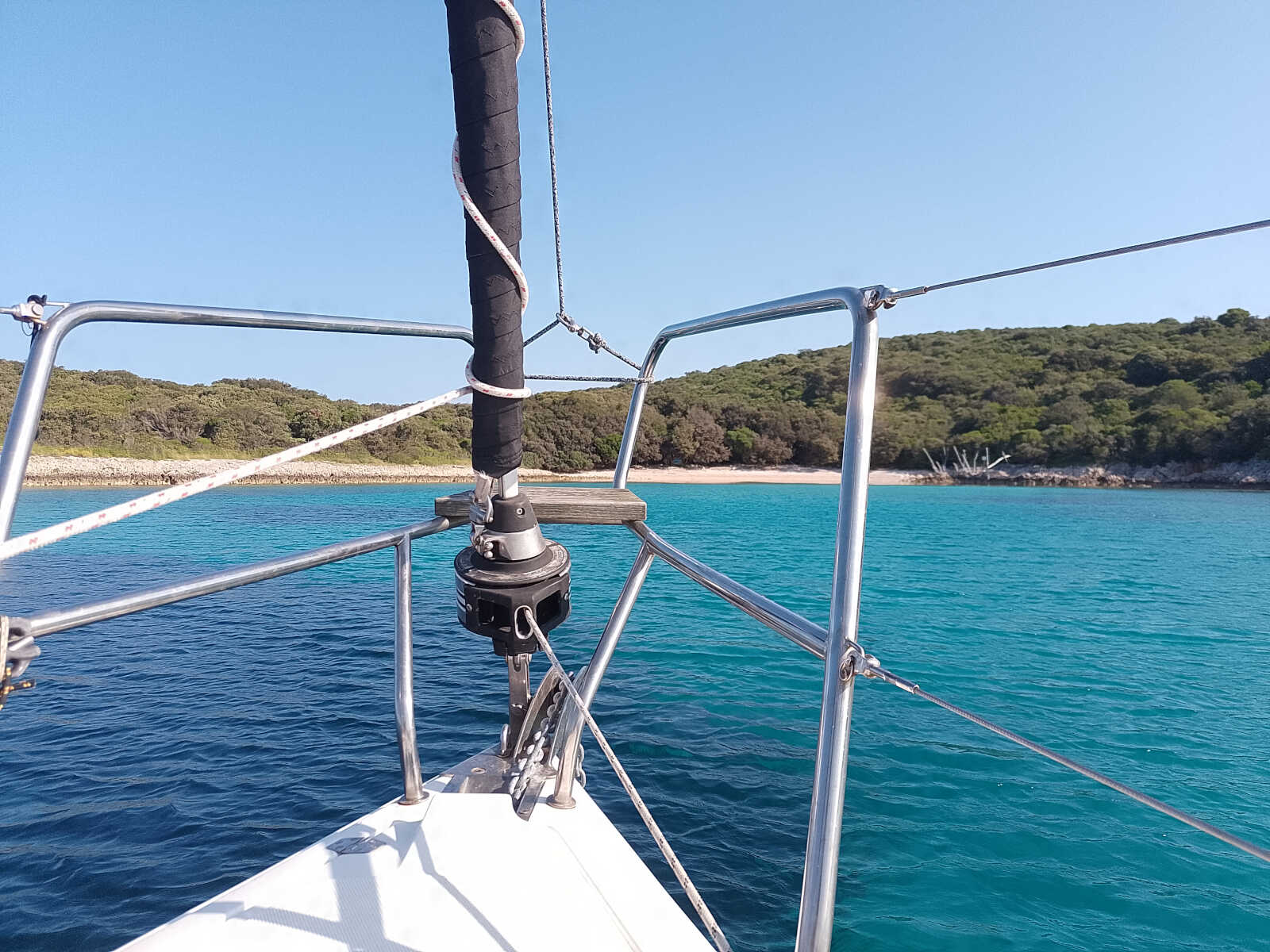
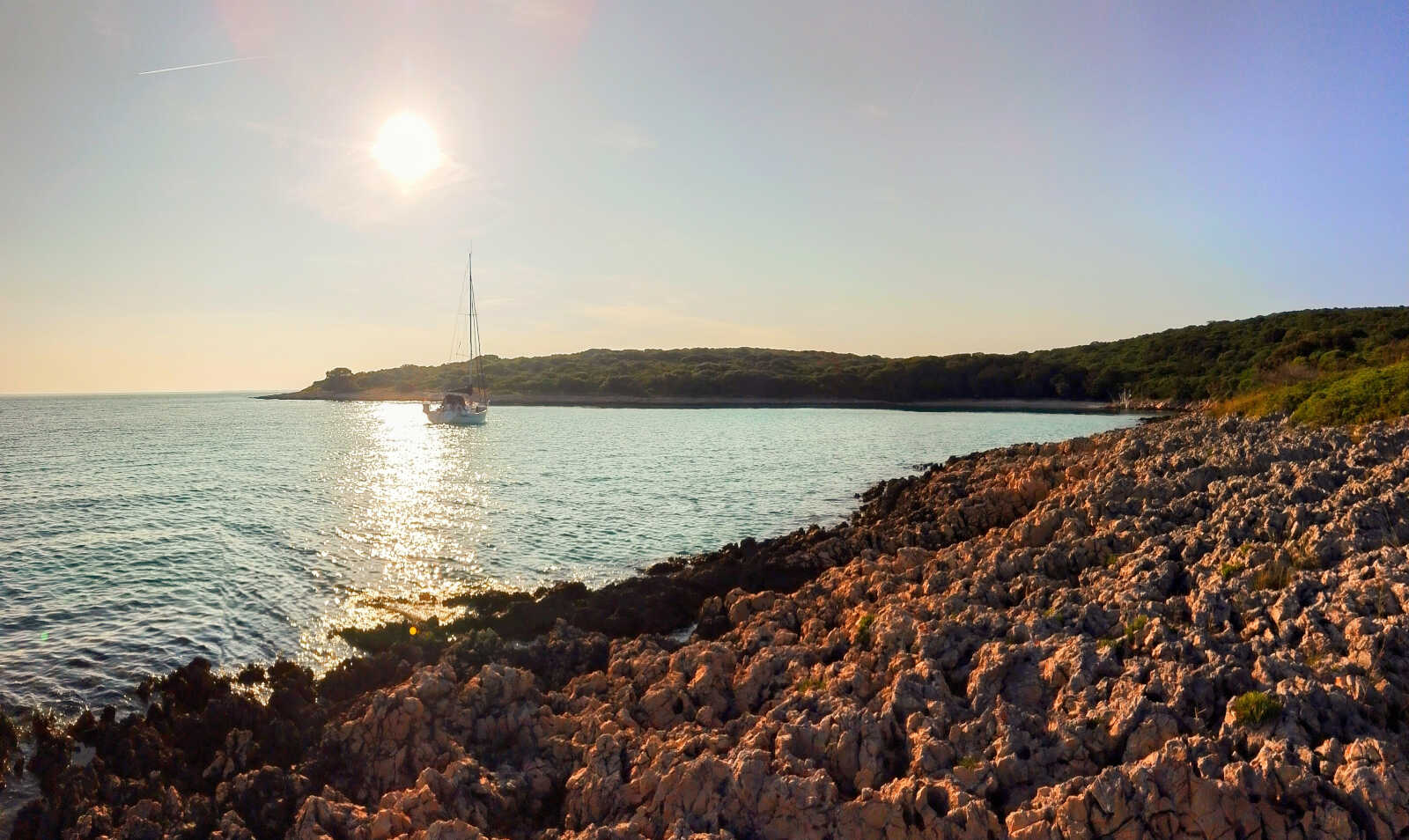
Il giorno dopo verso mezzogiorno siamo di nuovo per mare e ci sono condizioni per andare a vela. Le isole e isolotti di questa zona ci offrono suggestivi scorci.
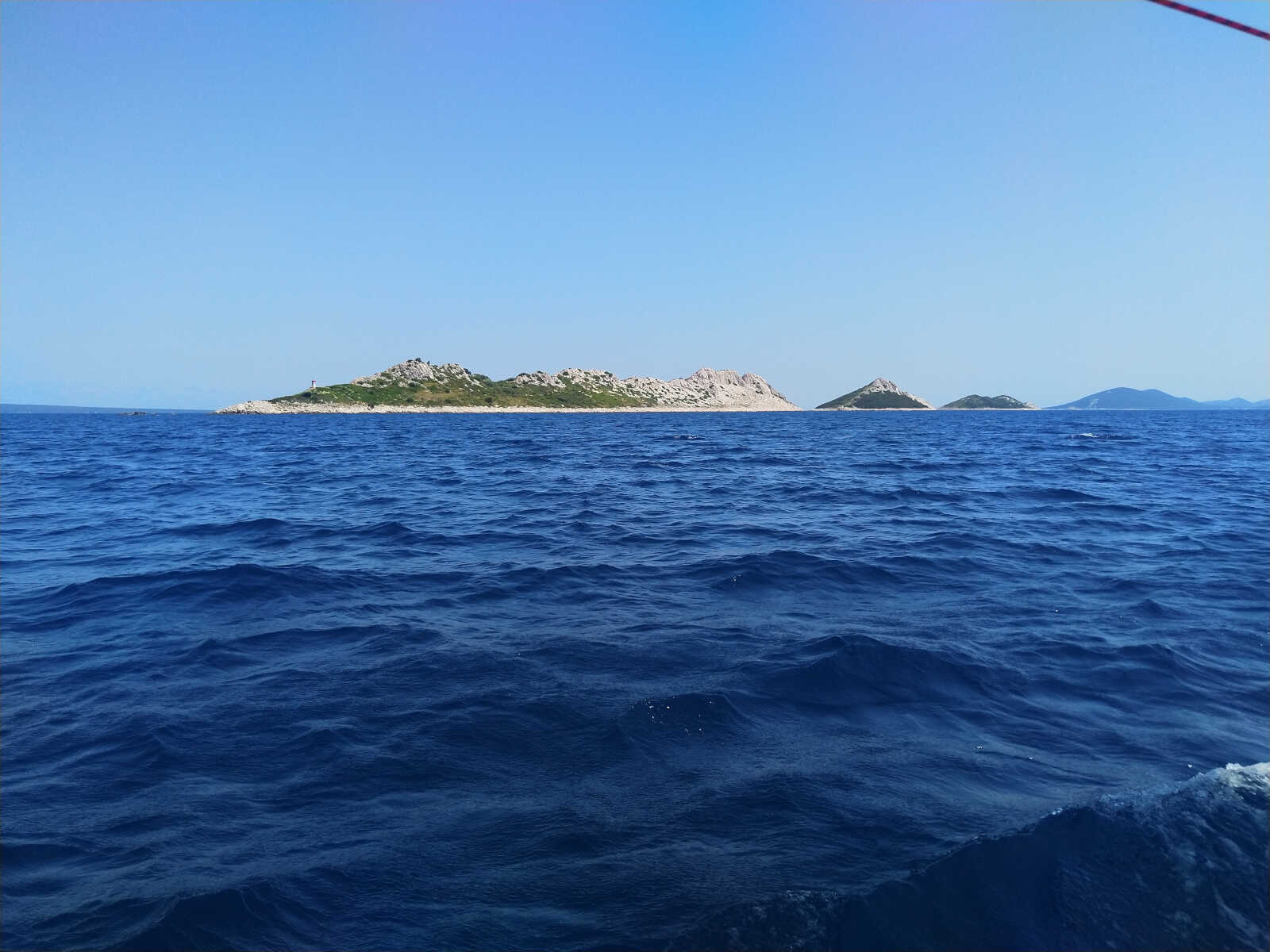
Copriamo le 11,5 M in poco più di 2 ore e diamo fondo nella grande baia a sud di Ist. Non scendiamo a terra perché il giorno dopo abbiamo altrettanta strada da fare.
Alle 1000 disancoriamo a vela senza usare il motore e ci inviamo con soli 5-6 n di vento (che diventeranno poi meno) nonostante le previsioni ne dessero 8 al lasco. Ci ostiniamo a non voler accendere il motore ma il vento resta debole e poco costante nella direzione.
Facciamo comunque 2 a volte 3 nodi. Gli altri manco a dirlo vanno a motore mentre noi bordeggiamo per risalire il vento.
Alla fine veniamo ripagati con 10-12 n di vento e copriamo le ultime miglia al traverso con punte di 7 nodi.
Per entrare a Veli Rat (la baia dove vogliamo affrontare il cattivo tempo che ormai danno per certo) bisogna affrontare uno stretto canale con una secca: meno male che la nostra esperienza veneziana ce lo fa affrontare con relativa fiducia nonostante in certi punti avessimo appena 20cm d'acqua sotto la chiglia.
Vediamo diverse altre barche che non se la sentono e fanno marcia indietro.
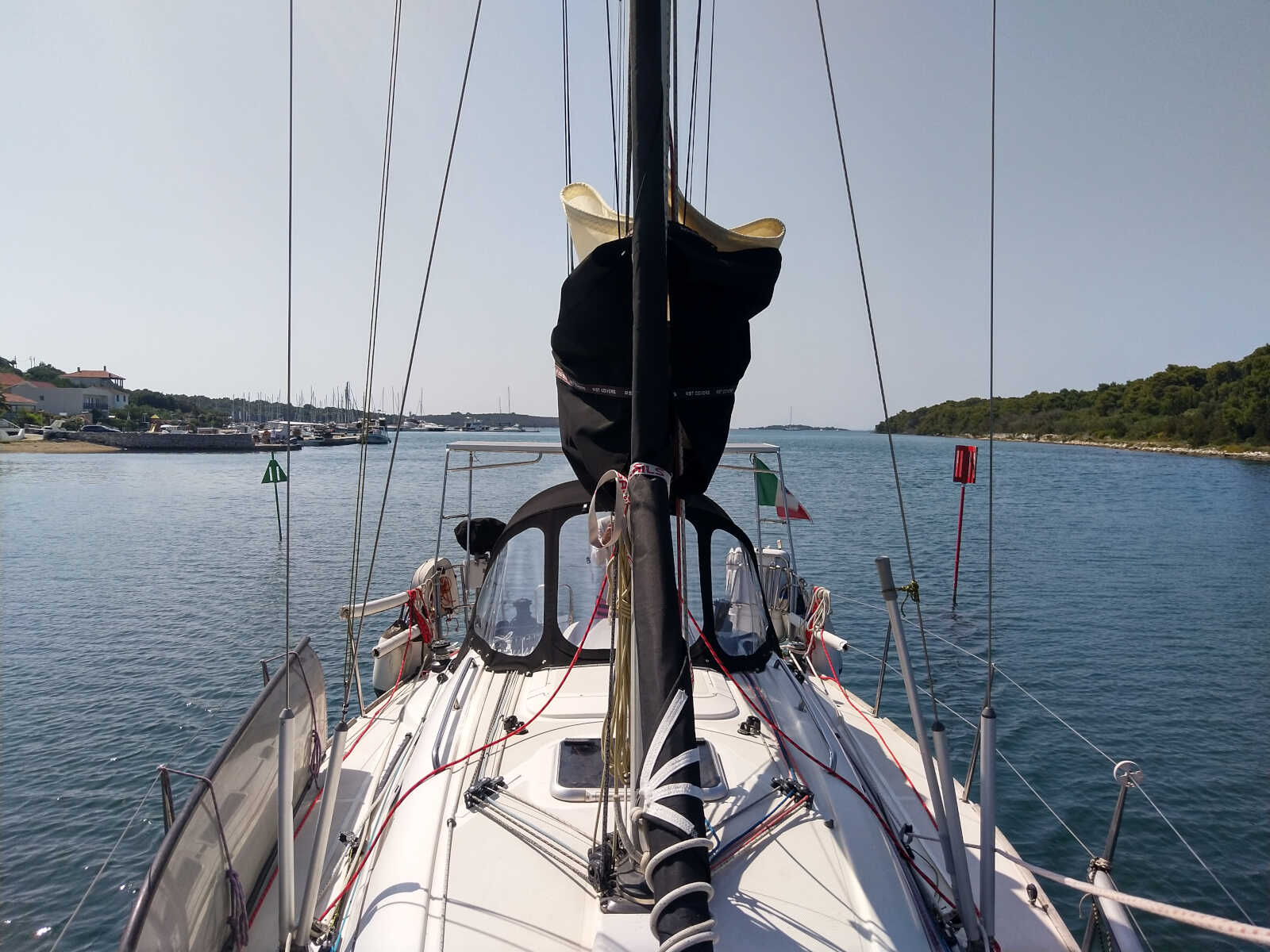
Ancoriamo in 3,5m d'acqua con fondo fangoso, ottimo tenitore, e siamo protetti praticamente da tutti i lati.
Siamo i primi ma pian piano arrivano altre 5 barche con la nostra stessa idea. È domenica e il maltempo è previsto per la notte di Lunedì. Abbiamo tutto il tempo per preparare la barca per i 40 n previsti: mettiamo degli stroppi a tutte le vele di prua per evitare che il vento si insinui e le faccia aprire, togliamo la copertura esterna, mettiamo preventivamente 35m di catena e sotto coperta sistemiamo tutto come se fossimo in modalità navigazione in modo che nulla possa cadere.
Stefan, il capitano di Joschi, ci invita a cenare da lui Lunedì sera. Sta di fatto che non siamo nemmeno al giro di amari che la tempesta arriva con una velocità impressionante.
Subito si passa da 20 a 30 n e poi 40 (gli strumenti registreranno raffiche fino a 48 n). Ormai non c'è modo di raggiungere la nostra barca e dobbiamo rassegnarci a guardarla da distante a bordo di un'altra barca: ci fa un po' strano ma Lilith sembra cavarsela bene. Lo stesso non si può dire di Joschi: una delle vele di prua comincia ad aprirsi e sbatte impazzita. Le raffiche fanno sbandare la barca fin con la falchetta in acqua e gli spruzzi delle onde ci lavano fino in pozzetto. Il tender si capovolge per 2-3 volte con il fuoribordo attaccato: sarà sicuramente inservibile. Per di più i 20 m di catena non bastano a tenere la barca al suo posto: ci stiamo pericolosamente avvicinando alla costa. Stefan accende il motore per togliere tensione alla catena. Poi mi metto io al timone per cercare di tenere la prua al vento finché lui cerca di fare qualcosa per la vela a prua. A un certo punto la vela salta completamente e si incaramella sullo strallo: almeno smette di sbattere ed è un miglioramento.
Secondo Stefan dovremmo raggiungere Lilith a nuoto e noi di base siamo d'accordo, ma lo convinciamo a riancorare fintanto che siamo ancora a bordo e possiamo aiutarlo.
Così facciamo e una volta issata, non senza difficoltà, l'ancora ci allontaniamo finalmente dalla riva.
Non appena abbiamo Lilith al traverso Mela si tuffa in acqua per raggiungerla per prima. Nel frattempo è calato il buio e dopo poche bracciate non la vedo più. Spero per il meglio e cerco di razionalizzare pensando a quanto sia brava a nuotare. Io intanto resto a bordo di Joschi per aiutare Stefan a riancorare. Con sollievo vedo la luce di fonda e le luci a bordo di Lilith accendersi. Melani è a bordo e ci sentiamo via radio.
Joschi è riancorata con 50 m di catena e non dovrebbe più avere problemi. Ora tocca a me: mi tuffo e per fortuna l'acqua è ancora calda, e sono a favore di onde e vento, che nel frattempo è calato a 35 n, e in un batter d'occhio copro i 70 m che mi separano da Lilith.
A bordo è tutto a posto e siamo entrambi euforici e pieni di adrenalina. Mi fumo una sigaretta bevendo un Di Saronno. Insieme analizziamo cosa è andato storto e cosa possiamo imparare e concludiamo quanto sia importante prepararsi per tempo e non abbassare mai la guardia.
Ci riproponiamo di mantenere la buona abitudine anche in futuro.
Il giorno dopo andiamo ad aiutare Stefan a salire in testa d'albero per provare a sistemare la vela. Alla fine decidiamo di mettere Melani al timone e srotolare la vela sfruttando il vento facendo fare degli ampi giri nella baia alla barca.
Il giorno dopo ancora lo aiuto a salire nuovamente sull'albero e finalmente la vela è sistemata: per fortuna non si è danneggiata eccessivamente, solo qualche cucitura da riprendere.
Siamo felici di essere riusciti di essere di aiuto ad un altro marinaio in difficoltà.
Il 18 dopo una bella notte di riposo, facciamo altre 12 M fino a U.Konopljica a SE di Molat. Anche qui passiamo una bella note da soli.
L'indomani copriamo le 14 M fino a U. Prtljug da dove scriviamo.
È uno dei pochi ancoraggi in zona che offre protezione da ovest a est e visto che era stato diramato un avviso di forte bora (che poi non si è materializzata) volevamo essere sicuri.
Infatti abbiamo venti da NO durante il giorno e NE di notte.
Siamo qui da qualche giorno e ne abbiamo approfittato per una grossa spesa nel paese di Uglijan sfruttando le nostre fidate bici, altrimenti sarebbero state più di un paio d'ore a piedi.
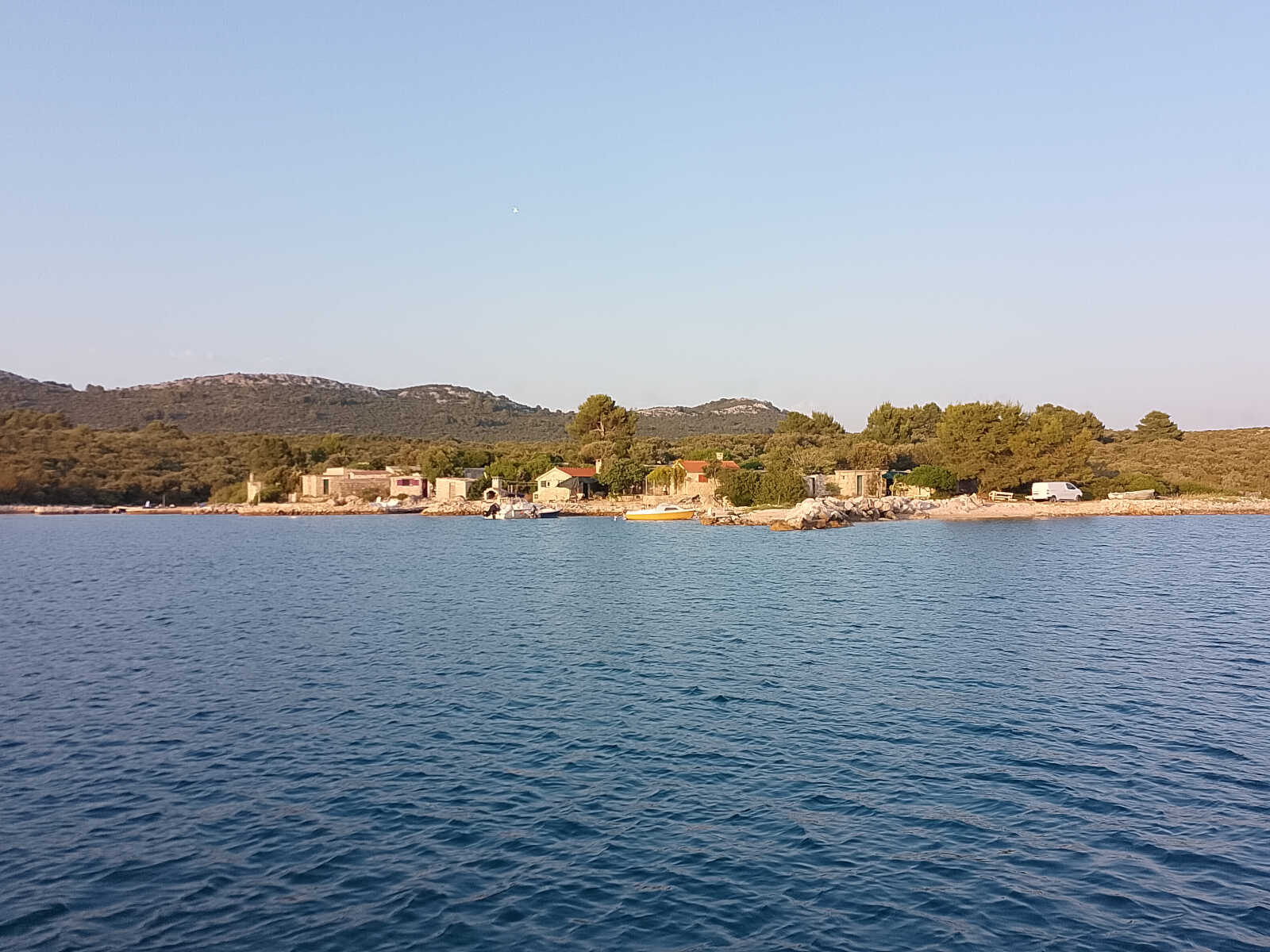
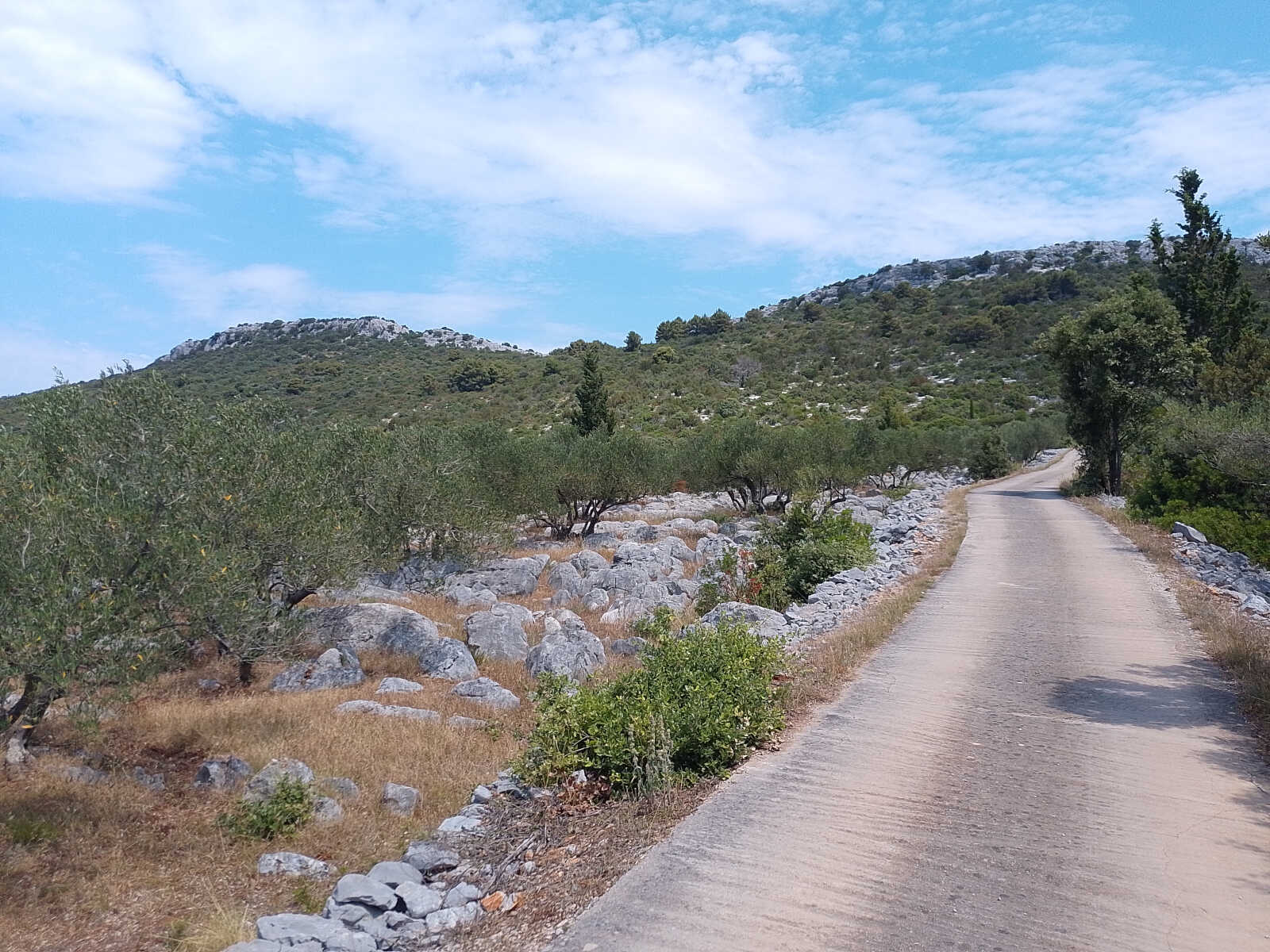
Encounters and misadventures (of others)
21 Jun, 2025
At the end of last post we were in Uvala Liski. In the early morning of June 9, around 0400, the northeast wind began to strengthen. In fact, the anchorage was less protected than the map analysis could suggest: the high mountains to the north of us made the wind accelerate and despite the reduced fetch (the space necessary for the wind on the water to create the wave motion), the 20 sustained knots, with gusts of 25, brought quite big waves into the bay. All the boats in the bay were evaluating what to do. In the meantime, we took care to put down more chain to avoid dragging. One by one the other boats left and it was just us and a solo German sailor we've already met at a couple of other anchorages. We decided to go too. We put a third reef to the main sail since it seemed like a good opportunity to test it. We added it this winter. While we were taking up the anchor, we saw that the other boat had started to lift its anchor but was having problems with its windlass: we couldn't do anything to help and we hoped it could get away without problems, fortunately he did. Surely being alone on a sailboat makes everything more complicated.
As soon as we left the bay we opened the stay-sail and the main: in winds and waves a sailboat is safer, more stable and comfortable with the sails open. Despite the little canvas, we were sailing fast; what a start of the day!
The moment we double the cape, the wind dropped to 13-15 knots and the waves disappeared. We were lazy and left the sails as they were since we were moving surprisingly well.
We sailed to Uvala Artaturi which was 8.5 miles away. It is a deep bay at the mouth of the Gulf of Lošinj.
We stayed a couple of nights and used it as a base to do some shopping at the very expensive mini-market, fill our water jerry-cans, dispose of accumulated waste and take a bike ride to Lošinj. The town is nice, although very touristy in the port area (from here many charters depart) but as soon as you enter the narrow streets you breathe a more authentic air.








On the 11th we sailed 12 miles southeast while reaching. Once again we competed successfully with boats much larger than us and the only one that surpassed us did so using the engine in addition to the sails, which made us a bit bitter: there were the perfect conditions to go sailing, but in order to get to the anchorage or port sooner, to be able to do as much as possible even on holiday, they pollute unnecessarily, they didn't care. Unfortunately, this is the case for most charters.
Finally, we arrived in the beautiful and remote Uvala Parzine, in the southernmost part of the island of Ilovik. Here we found Joschi, the German boat with which we had shared the misadventure in Uvala Liski. After so many times we met, we couldn't help but stop to say hello and introduce ourselves on our way to the beach with the tender. So far we are finding German more useful than any other language, since at this time of the season there are almost only Germans and Austrians!
The path that leads from the bay to the town of Ilovik is very beautiful: the air is scented by aromatic herbs (we even collected mint and wild lavender) and we enjoyed the glimpses of the olive fields delimited by the characteristic dry stone walls.
The island is renowned for its floral diversity.
The village is nice and quiet, we wanted to buy something at the convenience store but the €9 for a jar of live and the €7 for 100g of ham convinced us to leave with just a cabbage and a few tomatoes.






Meanwhile, a potential bad weather system with very strong winds started to appear in the weather forecasts. We still had a few days and we decided to make a couple of stops on the way to reach what we had identified as our refuge.
On the 13th we travelled about 7 M to a wild anchorage on the NO coast of Silba that we had everything to ourselves for the night.


The next day around noon we were back at sea and there were ideal conditions to go sailing. The islands and islets in this area offered an amazing scenery.

We covered the 11.5 M in just over 2 hours and we anchored in the large bay south of Ist. We didn't go ashore because the next day we had other miles to sail.
At 1000 we put up the anchor without using the engine and we left with only 5-6 n of wind (which will then become less) despite the forecasts gave 8 reaching. We insisted on not wanting to start the engine but the wind remained weak and not constant in its direction.
However, we did 2 sometimes 3 knots. The other boats were of course motoring while we tacked our way upwind.
At the end we were repaid with 10-12 knots of wind on the beam and covered the last miles with peaks of 7n of speed.
To enter Veli Rat (the bay where we wanted to face the bad weather that was now certain) you have to face a narrow canal with shallows. Thank to our Venetian experience we faced it with relative confidence, despite the fact that in some places we had just 20 cm of water under the keel.
We saw several other boats that tried, didn't feel up to it and backed out.

We anchored in 3.5 m of water on a muddy bottom, an excellent holder, and we were protected on practically all sides.
We were the first but during the day another 5 boats with our same idea arrived. That was Sunday and the bad weather was expected on Monday night. We had all the time to prepare the boat for the planned 40 knots of wind: we put straps on all the fore sails to prevent the wind from creeping in and unfurl them, we removed our shade cover, we put 35m of chain out and below deck we arranged everything as if we were in navigation mode so that nothing could fall.
Stefan, Joschi's captain, invited us to dinner on Monday night. We were not even at the digestifs that the storm arrived with an impressive speed.
Immediately it went from 20 to 30 knots and then 40 (the instruments will register gusts up to 48 knots). There was no way to reach our boat and we had to resign ourselves to watching it from a distance aboard another boat: it was a bit strange but Lilith seemed to be doing well. The same cannot be said of Joschi: one of the fore sails began to open and started to flog madly. The gusts made the boat heel with the gunwale in the water and the splashes of the waves sprayed us in the cockpit. The tender flipped over 2-3 times with the outboard attached: it was definitely going to be unusable. Moreover, the 20 m of chain were not enough to hold the boat in place: we were getting dangerously close to the coast. Stefan turned on the motor to take tension out of the chain. Then I took the helm to try to keep the bow in the wind while he was trying to do something for the fore sail. At a certain point the sail ripped the clew attachment and got twisted on the forestay: at least it was no longer flogging. It was an improvement.
Stefan wanted us to swim to Lilith and we basically agreed, but we convinced him to re-anchor as long as we were still on board and could help him.
So we did and once the anchor was up, not without difficulty, we finally moved away from the shore.
When we passed next to Lilith, Melani jumped in the water to reach it first. Meanwhile, the darkness had fallen and after a few strokes I could no longer see her. I hoped for the best and tried to rationalize thinking about how good she is at swimming. Meanwhile, I stayed aboard Joschi to help Stefan to re-anchor. With relief I saw the anchor light and the lights on board Lilith turned on. Melani was on board and called us on the radio.
Joschi was finally re-anchored with 50 m of chain and out of troubles. It was then my turn: I jumped in the water and luckily it was still warm, I was in favor of waves and wind, which in the meantime had dropped to 35 knots, and in the blink of an eye I covered the 70 m that separated me from Lilith.
Everything was fine on board and we were both euphoric and full of adrenaline. Time for a cigarette and a Disaronno. Together we analyzed what went wrong and what we could learn and concluded how important it is to prepare in time and never let your guard down.
We intend to maintain the good habit in the future.
The next day we went to help Stefan climb to the top of the mast to try to fix the sail. In the end, we decided to put Melani at the helm and unroll the sail by taking advantage of the wind, making the boat go round and round in the bay.
The next day I went back, he climbed the mast and finally the sail was back up on its furler: fortunately it was not excessively damaged, only a few stitches to take care of in a later moment.
We were happy to have been able to help another sailor in distress.
On the 18th after a good night's rest, we made another 12 nm to U.Konopljica SE of Molat. Here too we had a nice night sleep by ourselves.
The next day we covered the 14 nm to U. Prtljug.
It is one of the few anchorages in the area that offers protection from west to east and since a strong bora warning had been issued (which later did not materialize) we wanted to be sure.
In fact, we have NW winds during the day and NE at night.
We have been here for a few days and we took advantage of it for a big grocery shopping in the village of Uglijan using our trusted bikes, otherwise it would have been more than a couple of hours on foot.

